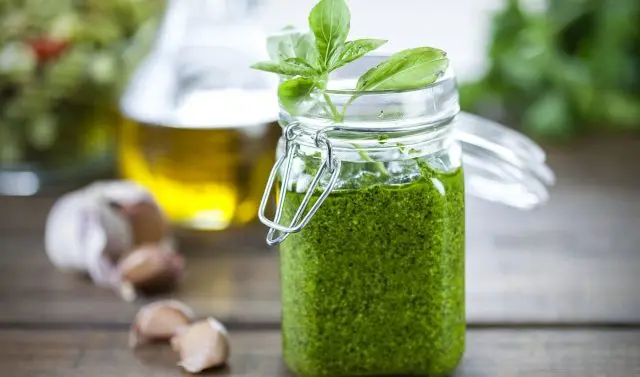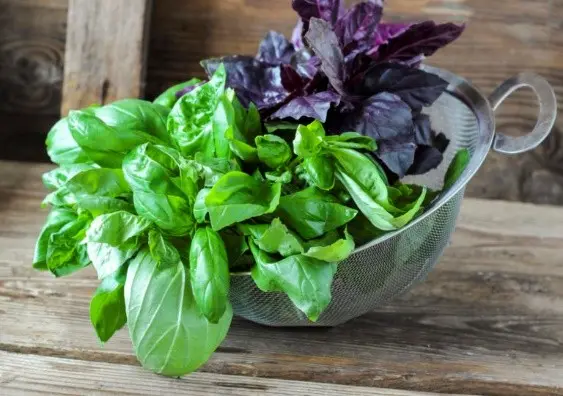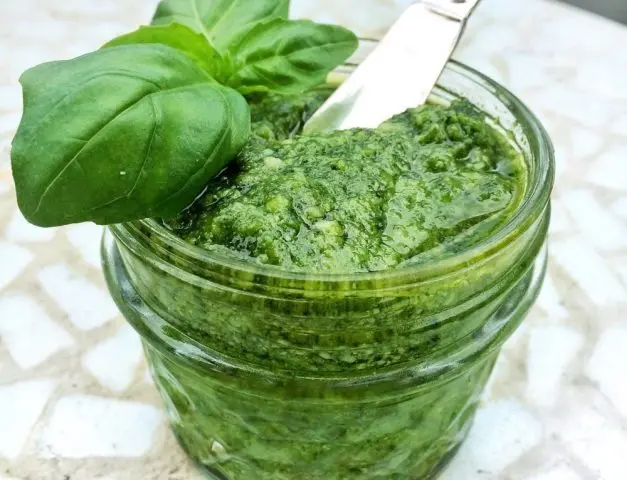Contents
Pasta with basil is a great way to keep the taste and aroma of the spice for the whole winter. Fresh herbs do not disappear from the shelves all year round, but it is the summer harvest that gives the dishes a “royal smell”. The amount of phytoncides, essential oils, carotenes in basil leaves is maximum when ripening outdoors.

How to prepare basil pasta for the winter
Basil has several color options: green leaves have a delicate, sweetish taste, purple varieties are more spicy and rich. Any variety is suitable for making pasta for the winter, but the workpiece has its own characteristics:
- Green varieties may have vanilla or caramel flavors, such basil is more suitable for desserts.
- Purple varieties are spicier and are used as a condiment. For pasta, choose varieties with cinnamon and clove aromas.
- The most interesting taste is obtained from blanks from mixed raw materials. For such recipes, purple and green basil are taken equally.
The taste of ordinary basil is well complemented by lemon or menthol varieties. Purple species have a sharper taste and smell, they contain 2 times more oils than green ones.
As soon as the first buds form on the basil, the amount of aromatic substances in the leaves is significantly reduced.
Ingredients
To prepare pasta with basil, you only need a few ingredients, the amount of which can be slightly varied.
Ingredients:
- Fresh basil – 500 g.
- Salt – 1 tbsp l.
- Vegetable oil – 100 ml.
Salt, which acts as a preservative, is added as needed. For long-term storage, you can significantly increase the rate, focusing on your own taste.
The classic composition of all seasonings with basil, as in Mediterranean dishes, involves the use of olive oil. If it is decided to replace it with another, vegetable, odorless varieties are chosen.

Preparing basil for pasta consists in carefully inspecting the leaves, removing all dried, spoiled specimens, washing and drying the shoots. Wet greens should be air-dried completely. So the water remaining on the leaves will not affect the safety of the workpiece.
Basil Paste Step by Step Recipe
Preparing basil does not take much time, as does the cooking process itself. All you need is a blender to grind and mix the ingredients. For packaging the finished paste, glass containers of small capacity are prepared with the possibility of tight closure. The optimal volume of jars is from 100 to 500 ml.
Cooking process:
- The basil, together with the uncoarse parts of the stems, is placed in a blender bowl, a part of the oil and the entire portion of salt are added.
- Whisk the mixture to a paste-like state.
- Pour in the rest of the oil and mix again.
- Lay out the product in sterile jars and close tightly.
Store the finished product in the refrigerator. To increase the shelf life before corking, the surface of the pasta is poured with a thin layer of olive oil.

There are pasta recipes for the winter that include vinegar and sugar. Such mixtures are seasoned to taste, being careful not to spoil the characteristic aroma by adding acid. The resulting pasta can be considered an independent seasoning and is not suitable for making classic Italian sauces.
Where can I add
Basil in the form of a paste, without any additives, can be used as a sauce for spaghetti, pasta, rice. Adding a few tablespoons of the mixture before the end of cooking adds flavor to the first courses. This quality is especially appreciated in the preparation of puree soups that do not differ in pronounced taste.
When baking meat, pasta is used for pre-treatment or as a sauce for a finished dish. Basil perfectly emphasizes the taste of poultry, pork, beef, game.
Pasta added to vegetable stew will make it taste stronger and give an appetizing smell. Tomatoes and basil are a classic combination, so the blank can be used for any dishes with tomatoes.
The taste of various cold salads can also be enriched with basil paste. The mixture can act as a sauce or an original additive. It is enough to mix 0,5 tsp into a regular dressing. pasta for a new, fresh sound to a familiar dish.

In winter, you can quickly prepare classic Italian sauces from ready-made basil mass or create new combinations from existing products:
- By adding nuts, garlic and grated parmesan, you get a pesto sauce that is used in many dishes or as a separate serving.
- From fresh, canned or sun-dried tomatoes, you can quickly prepare the original gravy for pasta. It is enough to warm the chopped tomatoes, add pasta, black pepper and garlic to taste.
- The preparation is applicable in risotto, can be included in potato dishes, added to mashed potatoes and when baking.
Terms and conditions of storage
Basil paste is stored in the refrigerator, the mixture does not tolerate room temperature. It makes no sense to sterilize the seasoning for the winter – this will destroy its unique taste. Subject to the sterility of preparation and packaging, the paste will stand for at least 12 months.
Adding salt extends the shelf life of basil. But even with complete preservation, the sauce will begin to lose flavor after 4 months. Vegetable oil reduces the life of a unique flavor bouquet to 90 days. Basil harvested in early autumn will stand without loss until the New Year holidays. Further, its properties gradually decrease.
After opening a sealed blank, the composition deteriorates quickly, so small containers should be used for conservation. Sometimes pasta is recommended to be frozen: it is convenient to add portioned cubes to dishes, and they have a longer shelf life. But this method will greatly affect the taste – the sauce will become less spicy.
Conclusion
Winter basil pasta is versatile and easy to use. It is this method that is considered the best for preserving the subtle flavors of the spice. Drying, freezing and pickling can lose the aromas of lemon, menthol and significantly reduce the content of essential oils in the leaves.









